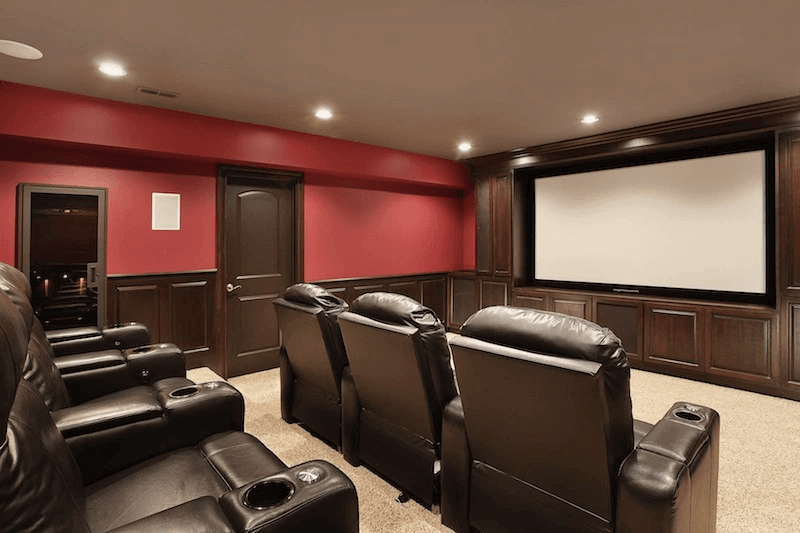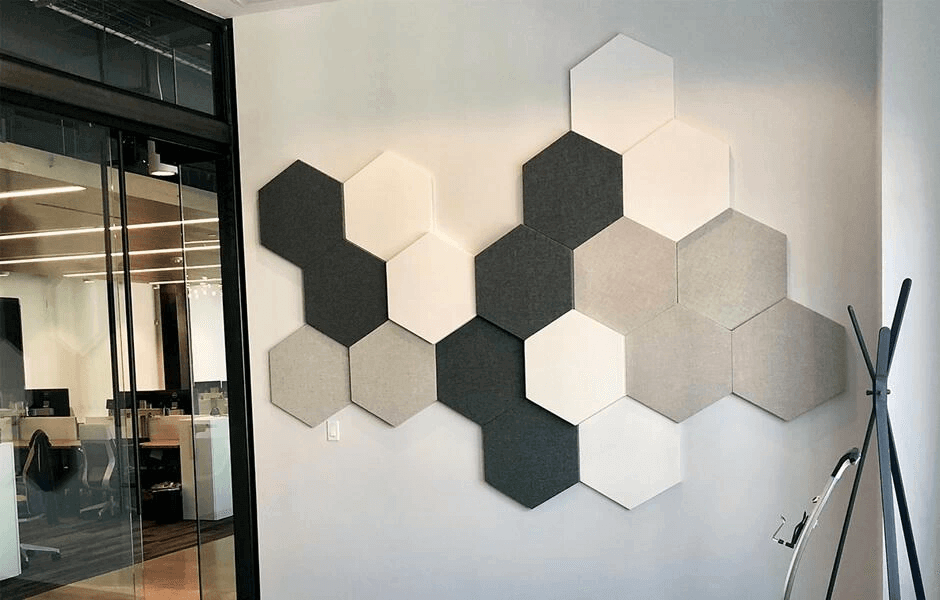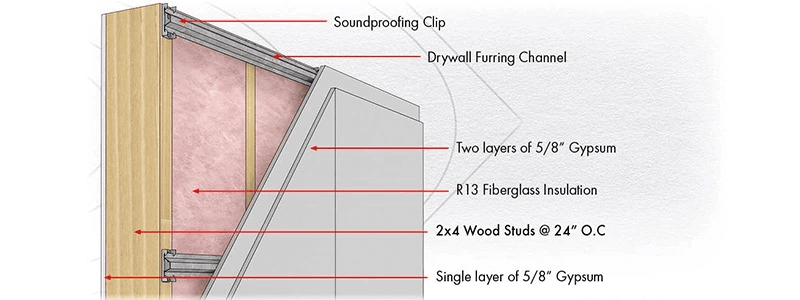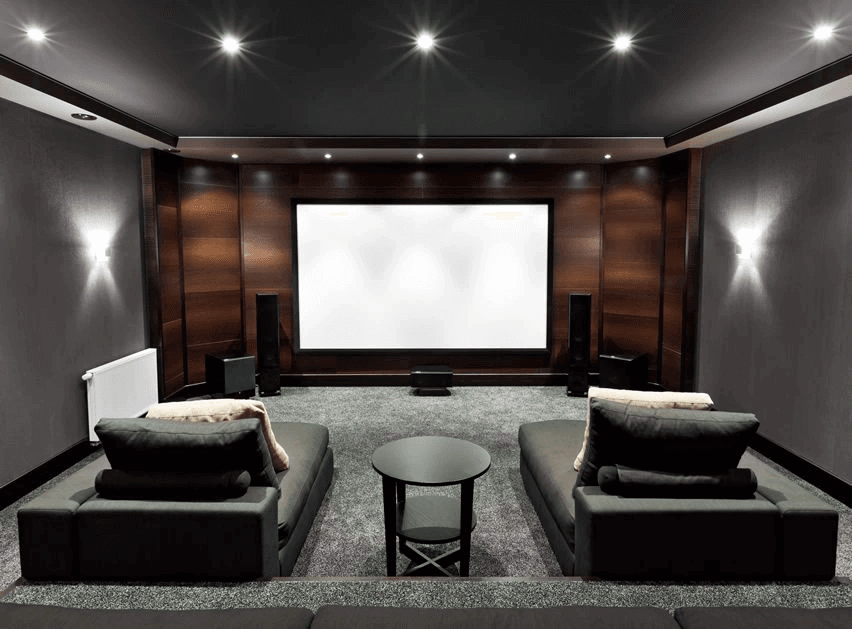How To Soundproof A Home Theater Room
Soundproofing your home theater can either be a quick job or a major structural change, depending on budget and how much freedom you actually have. For example, if you live in a rented property or apartment, there are probably rules against you ripping out the walls and replacing them with soundproof materials.

However, even if you’re not allowed to change the walls, there are still plenty of ways you can improve the sound absorption qualities of your home theater. Here are some of our top ways on how to soundproof a home theater room, ranging from small additions to major structural changes.
Absorbent Acoustic Panels
While these aren’t the best solution on the market, they actually do a pretty good job if you need something temporary. Acoustic panels are widely available online and will make a difference to the level of sound transferred through a wall.

However, it’s worth considering that you won’t be able to hang these all over the wall (you could, but it would cost a lot), and so you’re only really going to be making a superficial difference. But some careful placement around your speakers and subwoofers will make a bit of difference.
One of the benefits of using acoustic panels is that they come in a range of materials and designs, meaning they can blend in quite nicely on your walls, and can look like decorations instead of soundproofing equipment. However, as we mentioned above, they don’t make a massive difference, and so are only worth it if you can’t make structural changes.
Mass Loaded Barriers
Mass loaded vinyl is one of the most popular soundproofing materials and will be a good choice in your home theater. It’s basically a roll of vinyl that contains metal particles, and its sole job is to add mass to your walls.
It’s quite an interesting material because it has both elastic and viscous qualities. Rather than getting bogged down with all the science, all this means for you is that when presented with vibrations, the material simply absorbs them. It’s got just enough elasticity to absorb vibrations and keep its original shape.
The biggest thing to note with mass loaded vinyl is that it’s not the most attractive material in the world. You can either lay it on the interior side of the drywall so it’s hidden, or put it on the external side and paint it. Laying it inside the wall obviously means taking the wall down, but luckily it takes paint quite well and so shouldn’t present too much of a problem.
Decoupling Your Drywall
Decoupling is one of the most effective methods of soundproofing your home theater, but it does take a bit of DIY skill. However, the process itself isn’t too complicated, and can be completed in the following steps:

Take down the original drywall. Some guides suggest splitting this and replacing it, but I’ve found it works best by simply installing double thickness drywall on each side. After all, more mass is better.
Providing you’ve taken down the original drywall, you should now be left with just the studs, on which you can hang the new walls. For best results, fill the void with some kind of insulation foam. Again, the heavier the better.
Install decoupling mounts where you intend to hang the new wall. These are an essential component, and basically prevent vibrations from passing through the studs and into the other side of the wall.
Once the void has been filled with insulation and your decoupling mounts have been installed, it’s time to hang the drywall. This step is easy, and simply involves attaching the drywall to the decoupling mounts.
Now, paint the wall and it’ll look good as new.
The decoupling mounts and cavity insulation do a great job of working together. The mounts prevent the vibrations from passing through the wall, which means the only method of transference left is through the air, and this is where the insulation helps. It’ll absorb any sound waves, meaning you’ve got a pretty effective soundproofing barrier.
One of the only downsides of decoupling is that it’s not great against low frequencies, such as bass. To combat this, try adding more mass to each wall, as this will reduce the amount they can vibrate. Another solution is to add more, or heavier, insulation. This simply improves absorption, but can make a difference if you’re having trouble with your subwoofer.
Insulating The Walls And Ceiling
Insulating works on the principles of mass and damping, and is basically the same as what you’d do for decoupling. Filling voids between walls and ceilings will greatly reduce the amount of sound that carries, simply because there’s more mass in the way to absorb it.
Make sure you measure the surface area you’re going to be covering and decide whether you want to install the damping material onto or behind the drywall. Either is fine, but if you install the damping material in the room then you’ll have less choice over color. However, in some cases, practicality is better than looks.
Isolating Ceiling Joists
Ceilings are often overlooked when it comes to soundproofing a home theater, but they’re also one of the key areas to focus on. Although ceilings are more likely to have insulation already, their construction and materials mean they can transfer sound waves really easily.
When it comes to isolating your ceiling joists, the first step will be to tear down the old ceiling. You’ll then need to install some new joists, and isolate them from the existing ones. This can be done using mounts similar to decoupling the walls. In fact, it relies on the same logic, so it might make sense to do it at the same time.
We’d recommend looking for joists that will reduce the level of vibration. In short, this means the heavier the better, but more flexible materials will also be a benefit. You should hang the new joists about 2 inches lower than the existing ones, which does mean you’ll lose a bit of ceiling height.
If it’s not already, make sure you insulate the space between the ceiling and the floor above. Much like with decoupling, this will help to absorb any troublesome sound waves that have made their way through.
The Floor
Floors are also often overlooked when it comes to soundproofing a home theater, and are again one of the biggest culprits for sound transference. After all, they’ll carry any vibrations that pass through the walls, and are susceptible to both impact noise and airborne noise.

The best solution is to lay carpet with a thick, soundproof underlay. These products do exist, and they’re used in apartment buildings. Soundproof underlay does a great job, and while it might be more expensive than regular underlay, it saves you having to look for a DIY option.
If you have hardwood floors that you can’t replace, the only real option available is to lay some thick rugs. These won’t make a big difference, but will at least reduce impact noise and noise reflection. Choose the thickets rugs possible, and lay as much as you can.
The Floor
Doors and windows are notorious weak spots when it comes to soundproofing a home theater, and obviously there’s only so much you can do to improve this. Unlike walls, which can simply be loaded with mass, you can’t do much to a glass window. However, if you want the true theater experience, why not go all out and just remove them? This is the most straightforward way to deal with the issue.
Doors
Your only real option with doors is to replace them with heavier materials. You can buy soundproof doors, but they’re really expensive.
The first thing is to look at the frame itself. This can be a prime spot for sound escaping, and so you should seal the edges with some kind of silicone sealant.
Then there are the gaps around the door. You can buy jamb sealing kits, which are usually strips of material that just fill in the space. They’re actually pretty good, and do make a difference.
For the bottom of the door, the simplest thing is to buy a seal for it. Seals for the bottom of a door often have spring systems that allow them to drop into place when the door is in the frame, but lift up so you can still open the door.
To add an extra layer of material in front of my door, you could install a heavy velvet curtain to close across it. Although this isn’t necessarily the best option, it does make a difference. Plus, it’s one of the only things you can really do to a door, and it does add more mass to the space.
Windows
The simplest option is to just remove the windows. If you have a dedicated home theater, this shouldn’t be a problem, as natural light would only get in your way. However, if your home theater has another function, then you can’t really take the windows out.
If you need to keep the windows, the first thing you should do is use acoustic sealant round the edges. You should then consider using acoustic absorbing materials to line the window frame, as this will make a difference in the sound that can escape through the window.
If you don’t have it already, upgrade to double glazing. The gap between the two panes is essentially a vacuum, and so does a good job at absorbing sound. Double glazing will be your best option if you need to keep a window in your home theater.
A final option is to build a window plug. This is exactly what it sounds like: a plug you can fit over the window that will absorb sound. You could build one from a wooden frame that is filled with insulation. You can use mass loaded vinyl to cover it too for extra absorption.
The window plug should sit tightly in the frame, and you might want to add some felt around the edges to improve the fit. Remember, the tighter the fit, the more sound will be absorbed. Plus, it does a great job of blocking out light, which is helpful in a home theater.
HVAC Systems
HVAC vents are a problem area because they’re big holes in the wall attached to metal pipes. This makes sound travel so easily, and unfortunately, there are not loads you can do about it. However, you can make some minor adjustments that will help a bit.
Your first option is to install sound baffles. These basically consist of lots of angles and surfaces that disperse sound waves, and you fit them over the vents. Sound baffles should be your first option, and will probably be the most effective.
The next option is to use flexible tubes in your HVAC system. This will make it harder for sound waves to travel along the ducts, but does mean you’d have to rip out the existing structure. This option obviously isn’t possible for everyone, but is worth it if you can.
A final option is to use plenty of acoustic sealant. It’s worth covering all the gaps around a HVAC vent with the sealant, as it’ll make something of a difference. It’ll also help reduce sound waves travelling from the wall to the vent, and vice versa. Preventing the travel of sound waves is one of the most useful tactics when trying to soundproof a HVAC system.
Some Tips About Soundproofing Your Home Theater
As you can see, there are plenty of options for soundproofing your home theater. Rather than simply going for everything, it’s worth figuring out a plan by identifying your weakest areas and tackling those first. A bit of intelligent planning is much better than trying everything. For example, dealing with the areas around speakers will at least curb the amount of noise than can leak into walls and the floor.

Here are some final tips for soundproofing your home theater:
The success of your project will be determined by your budget, and what changes you can actually make. Be intelligent in your planning, and look for solutions that work with your existing space.
Don’t forget the importance of resonance. For example, you can make a big difference to sound transference by isolating your subwoofer. Putting it on a table will reduce the amount of sound waves transferring into the floor. Read my post on subwoofer placement.
Acoustic sealant is a must for any soundproofing project, and you should pay special attention to any small gaps. Sealing these will make a noticeable difference, and won’t cost much.
Although heavy drapes aren’t the most effective solution, they can make a difference if your options are limited. Velvet is a good choice, and make sure they’re as heavy as possible.
Adding mass should be one of your main priorities if you can’t make structural changes, as you should be able to simply fix things to the existing wall.
Remember, egg cartons do nothing!
Conclusion
Soundproofing your home theater can be a big job, but is definitely worth it if you like playing your audio loud. However, the process could get complicated and time-consuming, especially for first-timers. Therefore, we would recommend consulting with acoustic experts. Our experienced project managers from Acoustica Projects Sydney and Newcastle are always available to help you with all noise controlling and soundproofing needs!
Source: soundproofcentral

